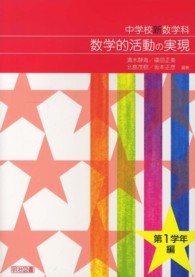- ホーム
- > 洋書
- > 英文書
- > Literary Criticism
Full Description
This book captures the intensity of the relationship between writers and their typewriters from the 1880s, when the machine was first commercialized, to the 1980s, when word-processing superseded it. Drawing on examples from the United States, Britain, Europe, and Australia, The Typewriter Century focuses on "celebrity writers," including Henry James, Jack Kerouac, Agatha Christie, Georges Simenon, and Erle Stanley Gardner, who wrote prolifically and mechanically, developing routines in which typing, handwriting, and dictation were each allotted important functions.The typewriter de-personalized the text; the office typewriter bureaucratized it. At the same time, some authors found a new and disturbing distance between themselves and their compositions while others believed the typewriter facilitated spontaneous and automatic typing. The Typewriter Century provides a cultural history of the typewriter, outlining the ways in which it can be considered an agent of change as well as demonstrating how it influenced all writers, canonical and otherwise.
Contents
List of IllustrationsAcknowledgments1. Introduction: The Typewriter as an Agent of Change?2. The Birth of the Typosphere 3. Modernity and the Typewriter Girl4. The Modernist Typewriter5. The Distancing Effect: The Hand, the Eye, the Voice6. The Romantic Typewriter7. Manuscript and Typescript8. Georges Simenon: The Man in the Glass Cage9. Erle Stanley Gardner: The Fiction Factory10. Domesticating the Typewriter 11. The End of the Typewriter Century and Post-Digital NostalgiaBibliography Index








